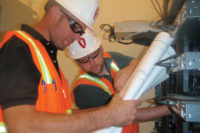I don’t believe we have ever had a time where there were so many changes regarding how we send signals to our central stations. DACT is changing; cellular generations are evolving at great speed with little or no concern about how these changes affect alarm systems. Added to this we now have a need for greater bandwidth.
DACT, commonly called “dialers,” is actually NFPA 72’s term for Digital Alarm Communicator Transmitter. NFPA 72 sets the reliability bar for alarm communications for both fire and burglary.
With the proliferation of Voice over Internet Protocol (VoIP), we now stand at the edge of what may be DACT’s demise. The last two editions of NFPA 72 began looking at the reliability of the “dialer” and have changed its use to one of two paths, where the second path must be another technology. Insiders within the NFPA 72 process are informally discussing eliminating DACT altogether. The next edition after 2016 could conceivably sunset DACT.
We’ve also seen the attempts at radio using 450 MHz and 900 MHz one-way and two-way evolving into “private radio.” None of the options at this point give us the bandwidth we will need with the growing use of streaming video.
The term Managed Facilities-based Voice Network (MFVN) was written in to the 2010 edition of NFPA 72. It defines a level of performance requirements for the use of VoIP as a substitute for the traditional POTS circuits.
Existing telephone companies are now in the process of transitioning from copper-based telephone to IP. The industry through the Alarm Industry Communications Committee (AICC) is attempting to have the essence of MFVN adopted by the FCC and telephone companies, to preserve our ability to send signals over the IP facilities.
Another issue is the need for bandwidth due to the emerging use of video. The need for streaming video creates the need for a greater bandwidth. Newer generations of cellular, 3G and most certainly 4G, are steps in that direction. Ultimately 5G will bring us a wide bandwidth medium.
From the latest AICC communications survey — which found 56 percent of new installations are still using DACT — it is apparent that DACT, regardless of NFPA 72, will be with us for some time to come. Unless DACT for new installations is totally abandoned, the sunset of the technology seems never to occur. As a result, it is imperative that MFVN rules be adopted by VoIP carriers.
In the early 90’s we fought to keep the “Baby Bells” out of the alarm industry. It was a partial victory, yielding a five year moratorium written into the Telecommunications Act of 1996. We will soon be faced with an update to that act.
What can we do to help ourselves in this situation? First, we should lobby for a favorable rewrite of the next Telecommunications Act; and, second, we should work with the FCC to have them adopt our MFVN suggestions.
We may not have the same fundamental issues we had in the 90s, but the security businesses may be even more threatened by the growth of telecom entities with power and resources to bury the legacy companies. They have grown and morphed in a fashion we never anticipated. What we want can be summed up simply in our asking for “a level playing field.”



